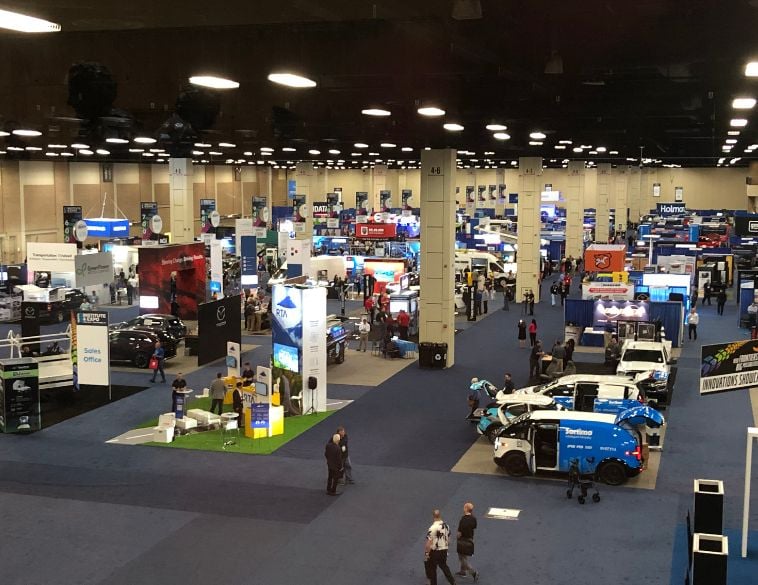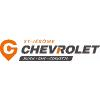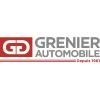The celebrated annual fleet expo provided a whole host of top quality content, networking, and product displays.
From April 21-24, the expansive Henry B. Gonzalez Convention Center in San Antonio, Texas, played host to the 2024 NAFA Institute & Expo (I&E). Fleet managers, vendors, association members, OEM representatives and other industry professionals from around North America and beyond descended on the event for in-depth learning, networking and an opportunity to view the latest products and solutions available.
During the opening general session, NAFA CEO Bill Schankel, CAE, donned a cowboy hat, welcoming attendees to I&E and Texas. Schankel stated that it was great to see so many people and that their “dedication to the fleet profession was inspiring.” He discussed the theme of I&E 2024 which was “New Frontiers and Big Possibilities.” Schankel provided an update on initiatives happening at the association, while also illustrating how NAFA continues to advance and provide new opportunities and possibilities for its members and the fleet industry.
These include the ability to showcase and implement new technologies, as well as innovative best practices, plus individual case studies and success stories that fleet management professionals can share and take back to their organizations.
Additionally, Schankel noted that I&E 2024 had a full day dedicated to safety practices, which represent an increasingly important part of fleet operations.
Ride and Drive Experience
Also making its debut for 2024 was an on-site Ride and Drive Experience, powered by Bobit, where attendees had the opportunity to sample a range of new vehicles with both conventional and alternative fuel powertrains. It proved a huge hit with attendees and on reflection, Schankel stated that “we were thrilled with the success of our inaugural Ride & Drive Experience at I&E 2024. This event really provided fleet professionals with an opportunity to engage with the latest automotive technologies and experience those vehicles that are driving our industry forward.” Participating OEMs included BMW, Lucid, Mercedes-Benz, Nissan, PoleStar, Rivian, Stellantis, Tesla, Toyota, Volkswagen and Volvo.
Another great aspect of I&E is that it provides the opportunity for fleets and individuals to be recognized for their commitment to excellence—both for their customers and the industry. During each opening session, Mike Brennan showcased NAFA’s 100 Best Fleets in the Americas, highlighting each of the winners in both the public and commercial fleet sector. On the final day of the event, the 2024 winners in each of the four categories of this program were announced.
- Best Public Fleet Award: Dakota County Fleet Management in Minn.
- Best Commercial Fleet: Essential Utilities
- Fleet Professional of the Year: Kenny Stimson, Carvana
- Fleet Technician of the Year: Curtis Mullins, City of Round Rock, Texas
Additionally, I&E brought together the latest graduates from the Certified Automotive Fleet Manager (CAFM) program who received their certificates on stage. Achieving CAFM status is a major feat and represents the marker of committed professionals who have demonstrated a wide range of knowledge and skills related to modern fleet management as well as a commitment to life-long learning. Additionally, I&E 2024 also had an on-site CAFM Live instruction program, where participants in the program had an opportunity to immerse and learn via eight in-depth module sessions—Asset Management, Business Management, Financial Management, Information Management, Maintenance Management, Professional Development, Risk Management and Fuel Management.
I&E 2024 also featured a number of general keynote sessions, where attendees got a chance to listen to subject matter experts on a variety of crucial topics.
On April 22, Recruiting and Retention in the new World of Work, sponsored by Holman, saw noted speaker and author Richard Hadden discuss effective ways in which to recruit, retain and engage employees in the post-pandemic workplace environment.
Hadden explained that while the COVID-19 pandemic was disruptive, it wasn’t an ignitor of major workplace changes but rather an amplifier of what was already happening. He explained that today, it was critical for organizations to understand the reality that there is a major shortage of trained workers, and that it was important for businesses to “get their own culture right” in order to attract the best and brightest employees. How the organization presents itself to potential hires is critical as well as its reputation, including genuine comments and feedback from those that work there. “Reputation recruits, reality retains,” said Hadden.
He also noted that in today’s environment it’s important for organizations to stop obsessing over skills and experience and instead focus on the right character and aptitude. He also suggested looking outside traditional recruiting channels and attracting people such as veterans and recent retirees and those that might have disabilities in one area but can be extremely effective workers in others.
Ultimately, he said it was important that both new hires and your existing employees feel like they matter and are contributing to something greater than themselves.
A complete package
On day two, the general session featured an industry update from Ted Cannis, CEO of Ford Pro, as well as an OEM panel discussion. Cannis provided an overview of Ford Pro’s solutions for fleets including a range of vehicles designed for different use cases, including those with conventional, hybrid and battery electric powertrains. Cannis noted that over the last few years Ford Pro has spent a considerable amount of time refining its EV strategy and working with customers to find optimal solutions for operating these vehicles. He mentioned that Ford Pro’s focus is to help fleets look for ways to run their businesses as effectively as possible. This includes finding ways to achieve optimal Total Cost of Ownership, improved sustainability, and better uptime, so those vehicles are on the road, earning revenue.
To that end, Cannis stated that Ford Pro’s objective was to come up with a complete suite of solutions. He noted that today, many fleets are facing pressure to deliver on sustainability targets, and this is impacting everything from duty cycles to procurement decisions, to operational costs and TCO. Cannis said that while state, provincial, and federal government incentives still exist, navigating them can be incredibly complex, plus the increased cost of living and doing business, fueled by higher inflation and interest rates has led to a very challenging operating environment for fleets.
Cannis explained that for those fleets looking to seriously commit to electrification, it is not about purchasing vehicles but rather an energy solution change, meaning that the vehicles are only part of a complete ecosystem that’s required in order to make EV adoption successful. “It’s the biggest energy solution change we’ve seen in 100 years,” said Cannis, “and if you think you’re just buying vehicles, you’re already in deep trouble.” That’s why he said, Ford Pro is approaching electrification as a complete one-stop shop for its customers, combining the vehicle, software and charging infrastructure as a complete package.

Mitigating supply chain challenges
The much-anticipated OEM panel discussion was moderated by Chris Brown from Bobit and featured Tom DeLuise from Toyota, Eric Swanson from Stellantis, Robert Wheeler from GM Envolve and Greg Wood from Ford Pro.
A key topic was the post-pandemic landscape and how supply chains are continuing to impact OEMs. Tom DeLuise noted that while things have improved, the impact of supply chain disruptions is still being felt, particularly among Tier 2 and Tier 3 suppliers to the OEMs. In the case of automakers like Toyota that still import some vehicles from Japan, transporting those to the East Coast of North America has required changes in logistics, such as importing them to the West Coast and then shipping them East via rail instead of taking them by ship directly to East Coast ports, due to restrictive access to the Panama Canal (due to local droughts). Not only are situations like this obstructing the flow of shipping traffic in the Americas, but they’re also significantly increasing shipping costs.
Greg Wood added that the growing complexity of vehicles and the greater amount of computing power required to operate them—requiring more software and semiconductor chips—is resulting in more components needed for each car and truck that rolls off the assembly line. The growing number of options and features on modern vehicles has also amplified the issue. Wood said that at Ford Pro, the emphasis is reducing options without reducing functionality to help combat this issue while still providing the features that customers expect. Wood also mentioned that Ford is working closely with upfitters to ensure software is compatible with different equipment, ensuring these vehicles work and operate as effectively as possible.
Another issue that many fleet managers have been facing, is difficulty in getting vehicles including the issue of orders being cancelled. Robert Wheeler said that order cancellation is something that all OEMs want to avoid. He also noted that while the ordering process isn’t perfect, the situation is starting to improve and that for the 2025 model year at least, he expects to see more free-flow ordering, which will help fleet managers get the vehicles they need, when they need them–a sentiment shared by his colleagues on the panel.
A range of options
On the hot topic of vehicle electrification, Tom DeLuise said that from Toyota’s perspective the term has always been about a range of propulsion technologies, including hybrid, plug-in hybrid, battery electric and hydrogen fuel cells and Toyota’s product mix represents all of these, as well as internal combustion engine vehicles which still represent the majority of vehicle sales.
DeLuise said that ultimately, it was about providing customers a range of options and ensuring that the dealer network is able to support that, including in those states and jurisdictions that currently have more aggressive ZEV targets. The panelists all concurred that when it comes to electrification, it is critical that OEMs have vehicles that suit their customers’ requirements, whether its internal combustion engine vehicles, battery electrics, hybrids, plug-ins, or a combination of.
Furthermore, aggressive EV legislative requirements currently being pushed by states such as California, Washington, New York, Vermont and provinces such as British Columbia and Quebec are increasingly seen as unrealistic in scope, which could further increase costs and reduce vehicle availability, something that was discussed during the NAFA Canadian Legislative update (which you can read about separately on autosphere.ca/fleet).
Education sessions
Besides the keynotes, which also included one entitled The Roadmap to Fleet Safety, sponsored by Shell Fleet Solutions, there were a whole host of informative education sessions that touched on everything from vehicle electrification and charging infrastructure development, to safety practices, state and federal policies, fleet maintenance, leveraging modern technology, KPIs, specific fleet case studies and vehicle acquisition/replacement amid ongoing supply chain challenges.
For the second year in a row, there was also a media day, where a number of vendors engaged with members of the press, discussing their product and solutions offerings and how they can make a difference in a fast-evolving marketplace. There was also an on-site Canadian Fleet Reception, sponsored by Mitsubishi Motors and an expansive Expo Hall where attendees could experience and sample the latest fleet industry vehicles, products and solutions.
Additionally, NAFA hosted its Innovation Showcase, where attendees could vote for their favourite innovation at the event. When the dust settled, Samsara was named the winner of the Innovation Showcase, People’s Choice Award. Samsara had on display its AI-Powered Safety Solutions—a single platform for businesses’ operations data including video-based safety, vehicle telematics, apps and workflows, smart equipment and site visibility. In celebrating the award, Bill Schankel, CAE, CEO of NAFA said that “as the fleet industry continues to evolve, we are proud to recoginze Samsara as the winner of our 2024 Innovations Showcase. “Their ground-breaking innovations exemplify the spirit of ingenuity and advancement that drives our industry forward.”






 SAINT-JÉRÔME
SAINT-JÉRÔME Full time
Full time


